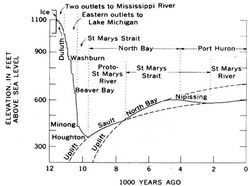Post-glacial rebound
2007 Schools Wikipedia Selection. Related subjects: Climate and the Weather
Post-glacial rebound (sometimes called continental rebound, isostatic rebound or isostatic adjustment) is the rise of land masses that were depressed by the huge weight of ice sheets during the last ice age, through a process known as isostatic depression. It affects northern Europe, especially Scotland and Scandinavia, Siberia, Canada, and the Great Lakes of Canada and the United States.
Overview
By the end of the last ice age about 11,000 years ago, much of northern Europe and North America was covered by ice sheets up to 3 km thick. The enormous weight of this ice caused the crust to sink into the fluid mantle. At the end of the ice age when the glaciers retreated, the removal of the weight from the depressed land led to a rapid uplift due to the buoyancy of crustal material relative to the mantle. Due to the extreme viscosity of the mantle, it will take many thousands of years for the land to reach an equilibrium level.
Studies have shown that the uplift has taken place in two distinct stages. The initial uplift was rapid, proceeding at about 7.5 cm/year. This phase lasted for about 2000 years, and took place as the ice was being unloaded. Once de-glaciation was complete, uplift slowed to about 2.5 cm/year, and decreased exponentially after that. Today, typical uplift rates are of the order of 1 cm/year or less, and studies suggest that rebound will continue for about another 10,000 years. The total uplift from the end of deglaciation will be about 400 m.
Effects
Post-glacial rebound has caused numerous significant changes to coastlines and landscapes over the last several thousand years, and the effects continue to be significant. In Sweden, Lake Mälaren was formerly an arm of the Baltic Sea, but uplift eventually cut it off and led to it becoming a freshwater lake in about the 12th century, at the time then Stockholm was founded at its outlet. Marine seashells found in Lake Ontario sediments imply a similar event in prehistoric times. In several Nordic ports, like Tornio, the harbour had to be relocated several times in the past centuries.
In Great Britain, glaciation affected Scotland but not Southern England, and the post-glacial rebound of northern Great Britain is causing a corresponding downward movement of the southern half of the island . This is leading to an increased risk of floods, particularly in the areas surrounding the lower River Thames. Along with rising sea levels caused by global warming, the post-glacial sinking of southern England is likely to seriously compromise the effectiveness of the Thames Barrier, London's most important flood defence, after about 2030 .
The Great Lakes of North America lie approximately on the 'pivot' line between rising and sinking land. Lake Superior was formerly part of a much larger lake together with Lake Michigan and Lake Huron, but post-glacial rebound raised land dividing the three lakes about 2100 years ago. Today, southern shorelines of the lakes continue to experience rising water levels while northern shorelines see falling levels.
In Sweden some of the most pronounced effects can be seen on the island of Oland, which has little topographic relief due to the presence of the very level Stora Alvaret. The rising land has caused the Iron Age settlement area to recede from the Baltic Sea, making the present day villages on the west coast set back unexpectedly far from the shore. These effects are quite dramatic at the village of Alby, for example, where the Iron Age inhabitants were known to subsist on substantial coastal fishing.
Globally, post-glacial rebound was tending to make the earth more spherical over time. However, this effect has been reversed by other factors such as large scale movements of ocean water caused by El Niño and related effects.
Legal status
In areas where the rising of land is seen, it is necessary to define the exact limits of property. In Finland, the "new land" is legally the property of the owner of the water area, not any land owners on the shore. Therefore, paradoxically, if the owner of the land wishes to build a pier over the "new land", he needs the permission of the owner of the water area.
